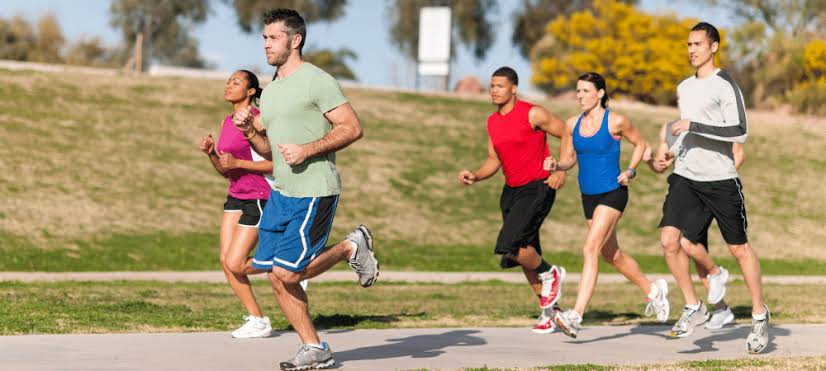According to WHO, Physical activity otherwise known as physical exercise refers to all movement including during leisure time, for transport to get to and from places, or as part of a person’s work. Both moderate- and vigorous-intensity physical activity improve health.
According to Wikipedia, It is defined as any voluntary bodily movement produced by skeletal muscles that requires energy expenditure. Physical activity encompasses all activities, at any intensity, performed during any time of day or night. It includes exercise and incidental activity integrated into daily activity.
Meanwhile, whichever definition you dcide to use doesn’t matter as what really matters is for you to understand the benefits and how it improves health. In schools, physical activities are taught as physical education which is often abbreviated as pe class.
Below are the four (4) amazing benefits of physical activity (health related fitness):
(1) Physical Activity Reduces Your Health Risk
1a) Cardiovascular Disease
Heart disease and stroke are two of the leading causes of death in the United States. Following the recommendations and getting at least 150 minutes a week of moderate-intensity aerobic activity can put you at a lower risk for these diseases. You can reduce your risk even further with more physical activity. Regular physical activities can also lower your blood pressure and improve your cholesterol levels.
1b) Type 2 Diabetes and Metabolic Syndrome
Regular physical activity can reduce your risk of developing type 2 diabetes and metabolic syndrome. Metabolic syndrome is some combination of too much fat around the waist, high blood pressure, low High Density Lipoproteins (HDL) cholesterol, high triglycerides, or high blood sugar. People start to see benefits at levels of physical activity below the recommended 150 minutes a week. Additional amounts of physical activities seem to lower risk even more.
Already have type 2 diabetes? Regular physical activities can help you control your blood glucose levels. To find out more, visit Diabetes and Me.
1c) Some Cancers
Being physically active lowers your risk for developing several commonly occurring cancers. Research shows that adults who participate in greater amounts of physical activities have reduced risks of developing cancers of the:
- Bladder
- Breast
- Colon (proximal and distal)
- Endometrium
- Esophagus (adenocarcinoma)
- Kidney
- Lung
- Stomach (cardia and non-cardia adenocarcinoma)
Improve your quality of life. If you are a cancer survivor, research shows that getting regular physical activities not only helps give you a better quality of life, but also improves your physical fitness.
Read Also: Types and Recommended Duration for your Physical Activity
(2) Strengthen Your Bones and Muscles

As you age, it’s important to protect your bones, joints, and muscles – they support your body and help you move. Keeping bones, joints, and muscles healthy can help ensure that you’re able to do your daily activities and be physically active. Doing aerobic, muscle-strengthening, and bone-strengthening physical activity at a moderately-intense level can slow the loss of bone density that comes with age.
Hip fracture is a serious health condition that can have life-changing negative effects, especially if you’re an older adult. Physically active people have a lower risk of hip fracture than inactive people.
Among older adults, physical activity also reduces the risk of falling and injuries from falls. Physical activity programs that include more than one type of physical activity are most successful at reducing falls and fall-related injuries. Different types of physical activity include aerobic, muscle strengthening, and balance physical activities.
Also, weight bearing activities such as running, brisk walking, jumping jacks and strength training produce a force on the bones. These activities that can help promote bone growth and bone strength and reduce the risk of fall-related injuries and fractures.
Regular physical activities helps with arthritis and other rheumatic conditions affecting the joints. Doing 150 minutes a week of moderate-intensity aerobic physical activity, if able, plus muscle-strengthening activity improves your ability to manage pain and do everyday tasks and improves quality of life.
Build strong, healthy muscles. Muscle-strengthening activities like lifting weights can help you increase or maintain your muscle mass and strength. This is important for older adults who experience reduced muscle mass and muscle strength with aging. Slowly increasing the amount of weight and number of repetitions you do as part of muscle strengthening activities will give you even more benefits, no matter your age.
(3) Improve Your Ability to do Daily Activities and Prevent Falls
A functional limitation is a loss of the ability to do everyday activities such as climbing stairs, grocery shopping, or playing with your grandchildren.
How does this relate to physical activity? If you’re a physically active middle-aged or older adult, you have a lower risk of functional limitations than people who are inactive.
Improve physical function and decrease the risk of falls. For older adults, multicomponent physical activity is important to improve physical function and decrease the risk of falls or injury from a fall.
Multicomponent physical activity is the type that includes more than one type of physical activity, such as aerobic, muscle strengthening, and balance training. Multicomponent physical activity can be done at home or in a community setting as part of a structured program.
Read Also: 13 Health Benefits of Jogging and The Effect on your Mind and Body
(4) Increase Your Chances of Living Longer
Science shows that physical activity can reduce your risk of dying early from leading causes of death, like heart disease and some cancers. This is remarkable in two ways:
- Only a few lifestyle choices have as large an impact on your health as physical activity. People who are physically active for about 150 minutes a week have a 33% lower risk of all-cause mortality than those who are physically inactive.
- You don’t have to do high amounts of activity or vigorous-intensity activity to reduce your risk of premature death. Benefits start to accumulate with any amount of moderate- or vigorous-intensity physical activity.
Reference
